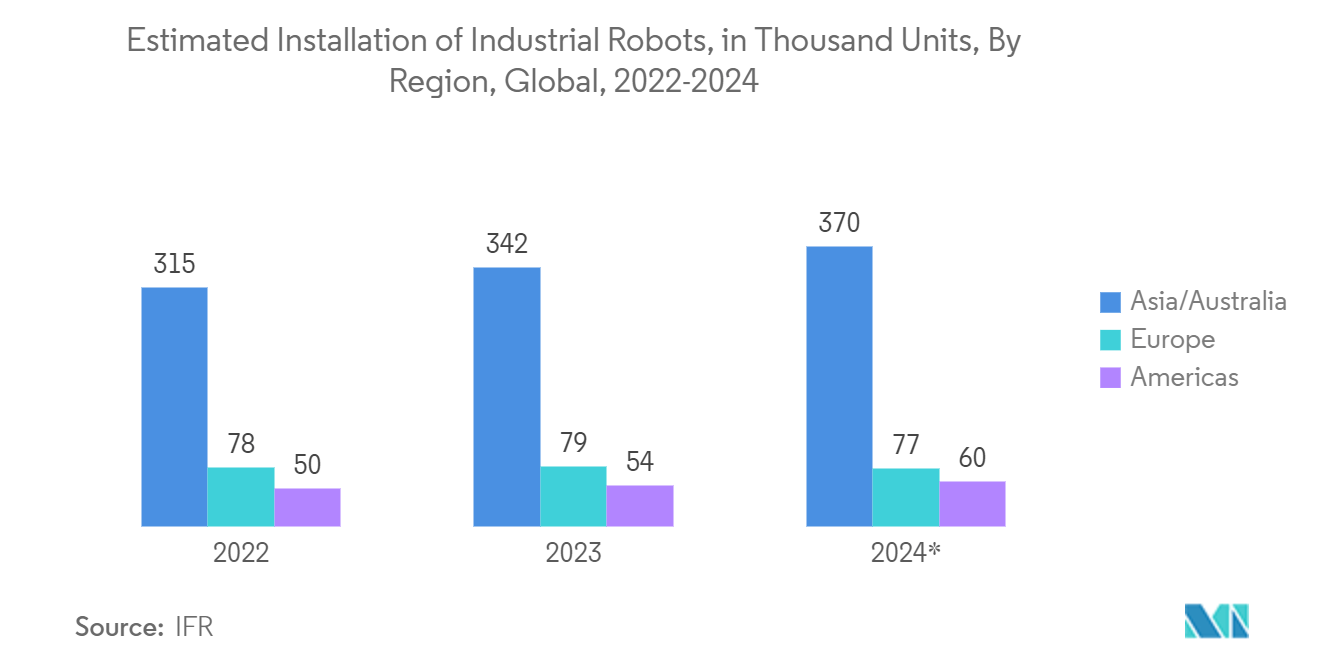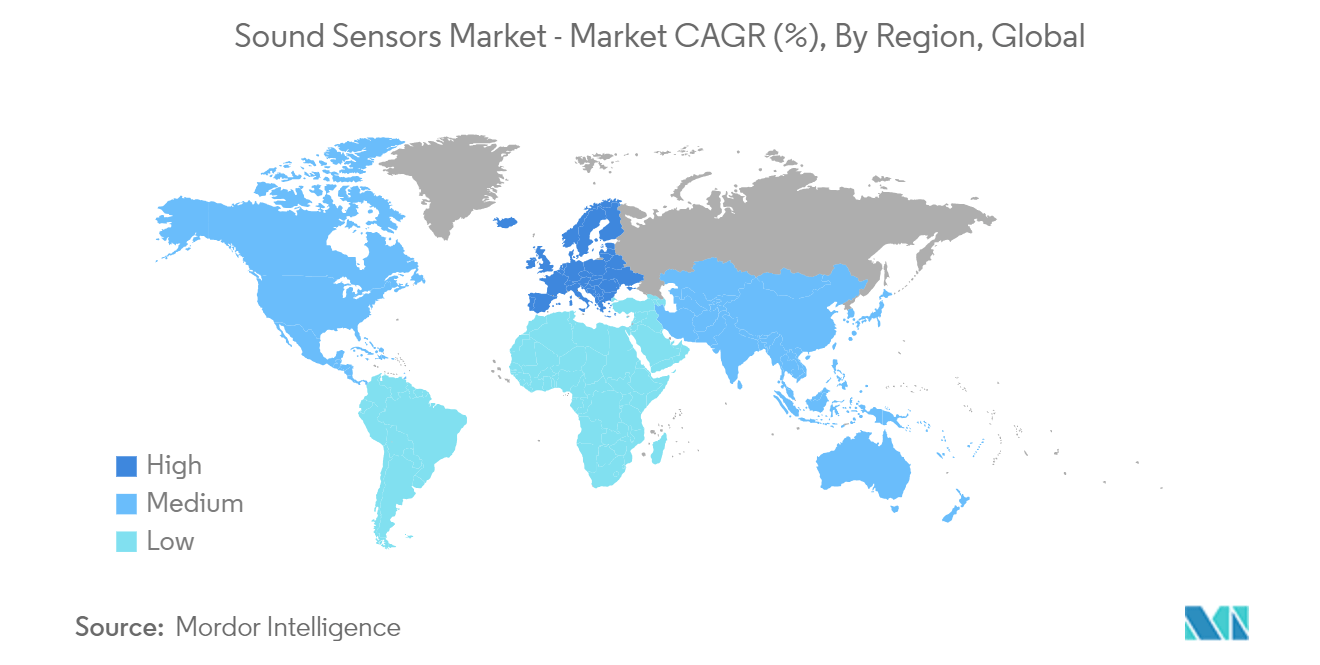Market Trends of Sound Sensors Industry
Industrial Sector to be the Fastest Growing End-user Industry
- Sound sensors are widely employed for various industrial purposes like monitoring machinery vibrations and noises and analyzing acoustic emissions generated due to fatigue failure on machine elements when equipment runs at high speeds. These devices provide data input into industrial automation systems, which allow machines or robots to execute tasks according to specific rules depending on corresponding parameters acquired through said detection components, leading toward more effective control over operations under different environmental conditions while increasing safety protocols significantly.
- The growing trend of Industry 4.0 and the use of robotics for various purposes in manufacturing, stock, and other units is expected to drive the market's growth. Germany is growing as a preferred hub for start-ups focusing on AI and its applications, such as machine learning, deep learning, computer vision, and predictive analytics. According to EU start-ups, Berlin is Europe's second-biggest start-up hub after London. Over 65% of German companies recently implemented Industry 4.0 practices, with the other 25% pitching to follow the ongoing suit.
- According to the IFR forecasts, the global adoption of industrial robots is expected to increase significantly to 518,000 industrial robots operational across factories worldwide by 2024. The significant growth trajectory of the industrial robot market is expected to drive the demand for the market studied. According to the same source, industrial robot shipments are expected to rise significantly in the coming years, surpassing the peak in 2022, when around 453,000 industrial robots were shipped worldwide. It is projected that by 2024, industrial robot installations in Asia/Australia are projected to reach 370,000 units.
- Many countries invest heavily and collaborate with other countries to create opportunities for manufacturers to strengthen their manufacturing industry. China is embracing the concept of the fourth industrial revolution (Industry 4.0) as part of its 10-year Made in China 2025 plan to catch up with manufacturing powerhouses like Germany and stand tall in competition with other developing countries with lower labor costs. It is an effort to modernize Chinese industry comprehensively. The plan focuses on ten areas: high-end computerized machinery, robotics, etc. Such initiatives in Industry 4.0 are anticipated to create opportunities in the market.
- The market has also been helped by a robust ecosystem sustaining the fast adoption of new technology in various regions. For instance, IIOT adoption and factory automation have aided the market, as the infrastructure required to maximize the utility of acoustic sensors is already in use in developed countries. Government initiatives such as "Made in America" are expected to drive the adoption of advanced technologies in the industrial domain, creating opportunities in the market during the forecast period.

Europe to Witness Significant Growth
- Sound sensors are widely employed for various industrial purposes like monitoring machinery vibrations and noises and analyzing acoustic emissions generated due to fatigue failure on machine elements when equipment runs at high speeds. As per 2023, with an annual output of GBP 183 (USD 232.5 Billion) billion, the United Kingdom remains the ninth-largest manufacturing nation in the world, according to Make UK. Moreover, in recent times, the rise of artificial intelligence (AI) and associated digital and robotic technologies has presented new opportunities for the country's manufacturers. It promises even greater levels of efficiency, productivity, and profitability.
- Moreover, developments and innovations in the defense system are also expected to boost the market. For instance, in June 2023, Elta Systems, a subsidiary of Israel Aerospace Industries, teamed up with German sonar manufacturer Atlas Elektronik to develop an anti-submarine warfare system. The firm announced its new partnership with Atlas, a subsidiary of Germany's Thyssenkrupp Marine Systems, aimed at launching a joint product, the BlueWhale anti-submarine warfare (ASW) variant. The system is based on Elta's autonomous underwater vehicle (AUV), integrated with Atlas's towed passive sonar triple array.
- Sound sensors are widely employed for various industrial purposes like monitoring machinery vibrations and noises and analyzing acoustic emissions generated due to fatigue failure on machine elements when equipment runs at high speeds. According to Make UK, with an annual output of GBP 183 billion (USD 231.98 billion), the United Kingdom remains the ninth-largest manufacturing nation in the world. Moreover, in recent times, the rise of artificial intelligence (AI) and associated digital and robotic technologies has presented new opportunities for the country's manufacturers. It promises even greater levels of efficiency, productivity, and profitability.
- The adoption of advanced technologies in the country's manufacturing industry is also aided by much government funding. For instance, in October 2022, UK Research and Innovation (UKRI) awarded 12 smart factory projects a share of GBP 13.7 million (USD 17.37 million) in funding to develop technologies that improve energy efficiency, productivity, and growth in manufacturing. It is a part of the government's wider GBP 147 million (USD 186.34 million) Made Smarter Innovation Challenge that seeks to increase the use of technology within UK manufacturing.
- In May 2022, the UK government revealed plans to boost manufacturing SMEs' productivity and competitiveness through a new Smart Manufacturing Data Hub (SMDH). The new hub and testbed were expected to be led by Ulster University and backed by GBP 50 million (USD 63.38 million) in government funds and business co-investment. Moreover, during the second pandemic, France launched design studies and built the first sections of a third-generation nuclear ballistic missile submarine to maintain national sovereignty and military independence.


